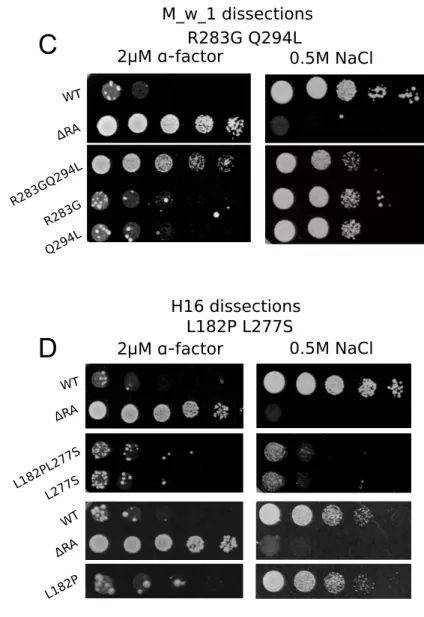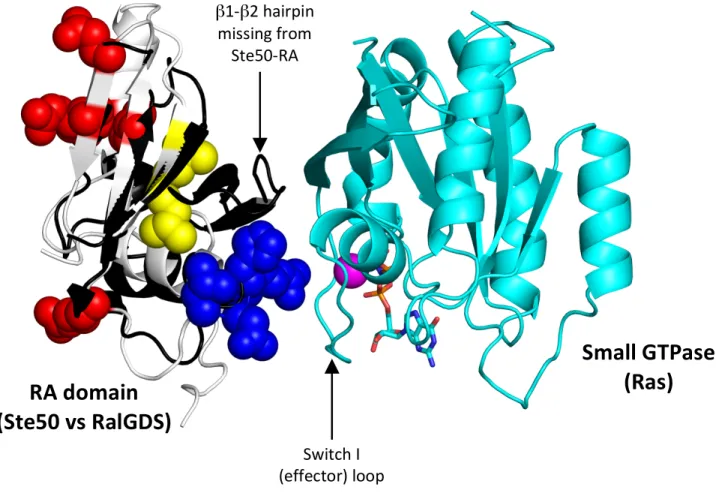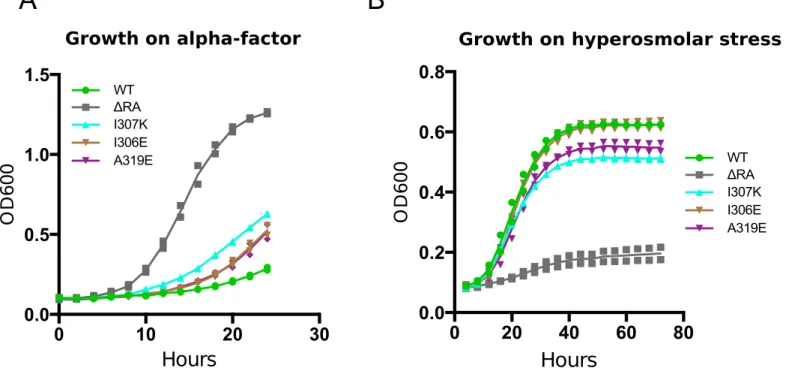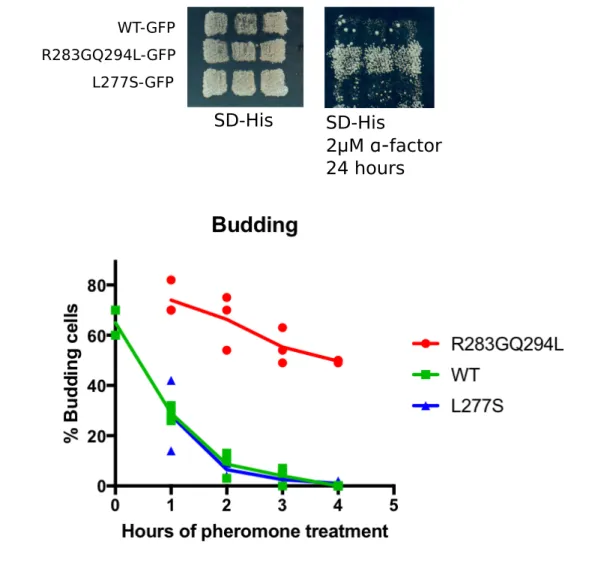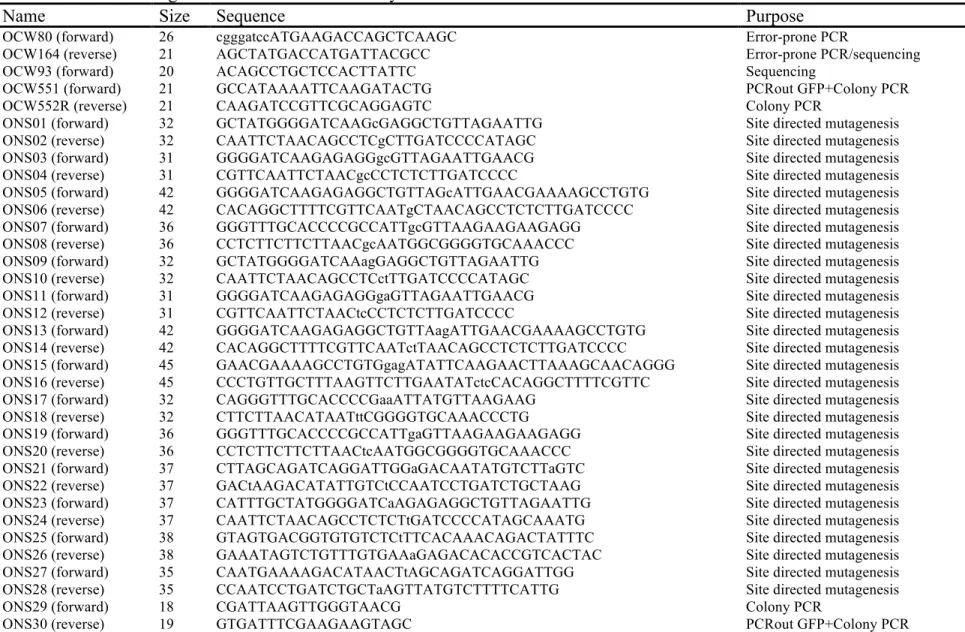Supplemental Materials
Molecular Biology of the Cell
WT ΔRA A242G N270DI289T A242G N270D N270D A242G I289T N270DI 289T A242G I289T K260NL300 VI307K K260N L300V I307K K260NL300 V K260NI 307K L300VI 307K FIGURE S1: Dissections of multiple mutations to �ind causal mutation(s). A, B and C) Mutants speci�ically defective in pheromone response with multiple mutations were dissected. Mutant R & G each containing 3 mutations and mutant M_w_1 containing two mutations were dissected into variants containing any possible single or any possible combinations of mutations. Clones were tested on alpha factor and NaCl selection plates. D) HOG signal defective mutant H16 containing two mutations were also dissected.
A
C
.D
ΔRA R283G Q294L R283G Q294L WT ΔRA WT ΔRA WT ΔRA L182P L182PL277S L277S 0.5M NaCl 2μM α-factor 2μM α-factor 2μM α-factor 0.5M NaCl 0.5M NaCl 2μM α-factor 0.5M NaCl Mutant G4 dissectionsMutant R6 dissections M_w_1 dissections
H16 dissections
B
WT A242G N270D I289T R283G Q294L K260N L300V I307K L182P L277S! ! ! ! ! ! ! ! ! ! ! ! ! ! ! ! ! ! ! ! ! ! ! ! ! ! !
FIGURE S2: Location of the functional interfaces of Ste50-RA domain mapped in this study relative to
the canonical interaction mode of RA domains with small GTPases. The image was generated by an overlay of the Ste50-RA domain structure (Ekiel et al., 2009) with the structure of the RalGDS-RA domain bound to the Ras small GTPase (Huang et al., 1998). The Ste50-RA domain structure is rendered as in Fig. 5A, with the pheromone signaling specific cluster in red and HOG signaling specific cluster in blue. The backbone of the overlaid RalGDS-RA domain is rendered in black. The structure of the small GTPase is rendered in cyan, with bound GTP analog (sticks) and Mg2+ ion (magenta sphere).
! !
Small!GTPase!
(Ras)!
β1#β2!hairpin! missing!from! Ste50#RA! domain! Switch!I! (effector)!loop!RA!domain!
(Ste50!vs!RalGDS)!
FIGURE S3: Growth assay of Ste50 RA domain mutant weak alleles speci�ically defective in pheromone response. A & B) Growth curves for yeast strain YCW1886 transformed with ste50 RA domain mutants indicated or with WT or RA domain deletion constructs at OD600 of ~0.1 were incubated in SD-ura selective media with either A) 2μM alpha factor for 24 hours or B) 0.5M NaCl for 72 hours and OD600 measured at 10 and 15 minutes intervals for pheromone and hyperosmolar stress respectively by TECAN machine. Data representative of two trials.
B
A
0 20 40 60 80 0.0 0.2 0.4 0.6 0.8Growth on hyperosmolar stress
Hours
OD 6 0 0 WT I307K I306E A319E ΔRA 0 10 20 30 0.0 0.5 1.0 1.5 Growth on alpha-factor Hours OD 6 0 0 WT I307K I306E A319E ΔRASte50 RA domain mutants defective in both pheromone response and HOG signaling Ste50 RA domain mutants
specifically defective in HOG signaling 2μM α-factor 0.5M NaCl 2μM α-factor 0.5M NaCl
B
A
FIGURE S4: Growth assay of ste50 mutants defective speci�ically in HOG pathway or in both HOG and pheromone response pathway signaling. Ste50 RA domain mutants indicated were transformed together with the control plasmids into YCW1886 yeast strain, overnight cultures were grown, serially diluted and spotted onto selective plates containing either 2μM alpha factor or 0.5M NaCl. A) Speci�ically HOG defective mutants. B) Mutants defctive in both the HOG and pheromone response pathways. S154YH275P H275R L277S WT ΔRA L322S I320K WT ΔRA ΔRA WT WT ΔRAA
B
FIGURE S5: GFP tagged proteins retain their respective phenotypic cell cycle arrest. A) Yeast strains bearing WT, R283GQ294L and L277S were grown on SD-ura and replicated onto the test alpha-factor plate. B) Same strains grown on SD-ura in liquid culturs to exponential phase and treated with 2μM alpha factor. Samples were collected at different time points and microscopically analyzed. Scored for the percentage of cells bearing different alleles of Ste50 for budding cells at different times of pheromone treatment. At least two biological replicates and 200 cells par sample were analyzed. WT-GFP R283GQ294L-GFP L277S-GFP SD-His SD-His 2μM α-factor 24 hoursTABLE&S1:!Ste50!RA!domain!point!mutants!with!no!selectable!phenotypes.!
Clone! Growth!on!!α=factor! Growth!on!NaCl! Mutations! disrupted!Pathway!
Clone!3! =! +++++! G246R3! None! M3! =! +++++! E261V4! None! M4! =! +++++! L297V2! None! M8! =! +++++! G343S! None! H15N! =! +++++! R325S! None! H6N_2! =! +++++! E302V! !None! H2N_3! =! +++++! R323G!E329G!A332G!! None! M8N! =! +++++! L316V! None! M11N! =! ++++! A242T!W282R! None! M12N! =! +++++! L212P!K309Q! None! M15N_2! +! ++++! Y285C!E329D! None! 3=1! =! +++++! H219Y!N276S! None!
Note: Superscripts denote number of recurrent hits.
TABLE&S2:!Stability!analysis!of!Ste50!RA!domain!mutants.!
!!!!!!!!!!!!!!!!!!!!!!!!!!!!!!!
!!!!!!!!!!!!!!!!!!!!!!!!!!!!!!!TABLE&S3:!Site!directed!mutagenesis!of!Ste50!RA!domain! SDM!Mutants! Alpha!factor! NaCl!
E295R! ?! +! L297E! ±! +! E299R! ?! +! I306E! +! +! A319E! +! +! E295A! ±! +! L297A! ±! +! E299A! ±! +! M321E! ±! +! !
? - Means no growth on alpha factor. Normal pheromone response. ? ± Means very low pheromone response defect.
? + Means detectable differential pheromone response defect compared to WT. ? + HOG means normal HOG signaling
TABLE S4: List of plasmids used in this study
Plasmids Descriptions Sources
pCW463(ΔRA) pRS316-ste501-218::URA3/AmpR Wu et al., 1999 pCW572 pRS313-ste50115-346::HIS3/AmpR This study
pCW267(WT) pRS316-STE50wt::URA3/AmpR Wu et al., 1999
pCW700 pRS313-ste50I320K::URA3/AmpR Ekiel et al., 2009 pCW701 pRS313-ste50R274AH275AN276A::URA3/AmpR Ekiel et al., 2009
pCW702 pRS313-ste50H275AN276A::URA3/AmpR Ekiel et al., 2009
pCW606 pYEX-4T2-ste501-257HIS3::URA3::LEU2/AmpR This study
pNS101 pRS316-ste501-218HIS3::URA3/AmpR This study pNS102 pRS316-ste501-346::URA3/AmpR This study
pNS103 pRS316-ste50A242GN270DI289T::URA3/AmpR This study
pNS104 pRS316-ste50A242G::URA3/AmpR This study pNS105 pRS316-ste50N270D::URA3/AmpR This study
pNS106 pRS316-ste50I289T::URA3/AmpR This study
pNS107 pRS316-ste50A242GN270D::URA3/AmpR This study pNS108 pRS316-ste50N270DI289T::URA3/AmpR This study
pNS109 pRS316-ste50A242GI289T::URA3/AmpR This study
pNS110 pRS316-ste50I307KL300VK260N::URA3/AmpR This study pNS111 pRS316-ste50I307K::URA3/AmpR This study
pNS112 pRS316-ste50L300V::URA3/AmpR This study pNS113 pRS316-ste50K260N::URA3/AmpR This study
pNS114 pRS316-ste50I307KL300V::URA3/AmpR This study
pNS115 pRS316-ste50L300VK260N::URA3/AmpR This study pNS116 pRS316-ste50I307KK260N::URA3/AmpR This study
pNS117 pRS316-ste50R283GQ294L::URA3/AmpR This study
pNS118 pRS316-ste50R283G::URA3/AmpR This study pNS119 pRS316-ste50Q294L::URA3/AmpR This study
pNS120 pRS316-ste50L182PL277S::URA3/AmpR This study pNS121 pRS316-ste50L182P::URA3/AmpR This study pNS122 pRS316-ste50L277S::URA3/AmpR This study pNS123 pRS316-ste50L322S::URA3/AmpR This study
pNS124 pRS316-ste50H275R::URA3/AmpR This study
pNS125 pRS316-ste50S154YH275P::URA3/AmpR This study pNS126 pRS316-ste50V288DD338V::URA3/AmpR This study
pNS127 pRS316-ste50R296G::URA3/AmpR This study
pNS128 pRS316-ste50I289VR323G::URA3/AmpR This study pNS129 pRS316-ste50I289VR323G::URA3/AmpR This study pNS130 pRS316-ste50K260EC290S P304S::URA3/AmpR This study
pRS313-GFP pRS313-STE50-GFP::HIS3/AmpR Slaughter et al., 2008 pNS131 pRS313-ste50R283GQ294LGFP::HIS3/AmpR This study
pNS132 pRS313-ste50L277S-GFP::HIS3/AmpR This study
pNS133 pRS313-ste50R296G-GFP::HIS3/AmpR This study pNS134 pRS316-ste50E295R::URA3/AmpR This study
pNS135 pRS316-ste50L297E::URA3/AmpR This study pNS136 pRS316-ste50E299R::URA3/AmpR This study
pNS137 pRS316-ste50I306E::URA3/AmpR This study
pNS138 pRS316-ste50A319E::URA3/AmpR This study pNS139 pRS316-ste50E295A::URA3/AmpR This study
pNS140 pRS316-ste50L297A::URA3/AmpR This study
pNS141 pRS316-ste50I297E::URA3/AmpR This study pNS142 pRS316-ste50E299A::URA3/AmpR This study
pNS143 pRS316-ste50M321A::URA3/AmpR This study
pNS144 pRS316-ste50M321E::URA3/AmpR This study
TABLE S5: List of oligonucleotides used in this study.
Name Size Sequence Purpose
OCW80 (forward) 26 cgggatccATGAAGACCAGCTCAAGC Error-prone PCR
OCW164 (reverse) 21 AGCTATGACCATGATTACGCC Error-prone PCR/sequencing OCW93 (forward) 20 ACAGCCTGCTCCACTTATTC Sequencing
OCW551 (forward) 21 GCCATAAAATTCAAGATACTG PCRout GFP+Colony PCR OCW552R (reverse) 21 CAAGATCCGTTCGCAGGAGTC Colony PCR
ONS01 (forward) 32 GCTATGGGGATCAAGcGAGGCTGTTAGAATTG Site directed mutagenesis ONS02 (reverse) 32 CAATTCTAACAGCCTCgCTTGATCCCCATAGC Site directed mutagenesis ONS03 (forward) 31 GGGGATCAAGAGAGGgcGTTAGAATTGAACG Site directed mutagenesis ONS04 (reverse) 31 CGTTCAATTCTAACgcCCTCTCTTGATCCCC Site directed mutagenesis ONS05 (forward) 42 GGGGATCAAGAGAGGCTGTTAGcATTGAACGAAAAGCCTGTG Site directed mutagenesis ONS06 (reverse) 42 CACAGGCTTTTCGTTCAATgCTAACAGCCTCTCTTGATCCCC Site directed mutagenesis ONS07 (forward) 36 GGGTTTGCACCCCGCCATTgcGTTAAGAAGAAGAGG Site directed mutagenesis ONS08 (reverse) 36 CCTCTTCTTCTTAACgcAATGGCGGGGTGCAAACCC Site directed mutagenesis ONS09 (forward) 32 GCTATGGGGATCAAagGAGGCTGTTAGAATTG Site directed mutagenesis ONS10 (reverse) 32 CAATTCTAACAGCCTCctTTGATCCCCATAGC Site directed mutagenesis ONS11 (forward) 31 GGGGATCAAGAGAGGgaGTTAGAATTGAACG Site directed mutagenesis ONS12 (reverse) 31 CGTTCAATTCTAACtcCCTCTCTTGATCCCC Site directed mutagenesis ONS13 (forward) 42 GGGGATCAAGAGAGGCTGTTAagATTGAACGAAAAGCCTGTG Site directed mutagenesis ONS14 (reverse) 42 CACAGGCTTTTCGTTCAATctTAACAGCCTCTCTTGATCCCC Site directed mutagenesis ONS15 (forward) 45 GAACGAAAAGCCTGTGgagATATTCAAGAACTTAAAGCAACAGGG Site directed mutagenesis ONS16 (reverse) 45 CCCTGTTGCTTTAAGTTCTTGAATATctcCACAGGCTTTTCGTTC Site directed mutagenesis ONS17 (forward) 32 CAGGGTTTGCACCCCGaaATTATGTTAAGAAG Site directed mutagenesis ONS18 (reverse) 32 CTTCTTAACATAATttCGGGGTGCAAACCCTG Site directed mutagenesis ONS19 (forward) 36 GGGTTTGCACCCCGCCATTgaGTTAAGAAGAAGAGG Site directed mutagenesis ONS20 (reverse) 36 CCTCTTCTTCTTAACtcAATGGCGGGGTGCAAACCC Site directed mutagenesis ONS21 (forward) 37 CTTAGCAGATCAGGATTGGaGACAATATGTCTTaGTC Site directed mutagenesis ONS22 (reverse) 37 GACtAAGACATATTGTCtCCAATCCTGATCTGCTAAG Site directed mutagenesis ONS23 (forward) 37 CATTTGCTATGGGGATCaAGAGAGGCTGTTAGAATTG Site directed mutagenesis ONS24 (reverse) 37 CAATTCTAACAGCCTCTCTtGATCCCCATAGCAAATG Site directed mutagenesis ONS25 (forward) 38 GTAGTGACGGTGTGTCTCtTTCACAAACAGACTATTTC Site directed mutagenesis ONS26 (reverse) 38 GAAATAGTCTGTTTGTGAAaGAGACACACCGTCACTAC Site directed mutagenesis ONS27 (forward) 35 CAATGAAAAGACATAACTtAGCAGATCAGGATTGG Site directed mutagenesis ONS28 (reverse) 35 CCAATCCTGATCTGCTaAGTTATGTCTTTTCATTG Site directed mutagenesis ONS29 (forward) 18 CGATTAAGTTGGGTAACG Colony PCR
